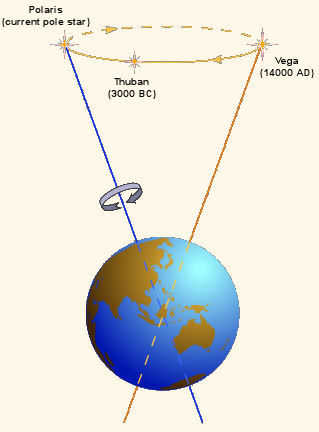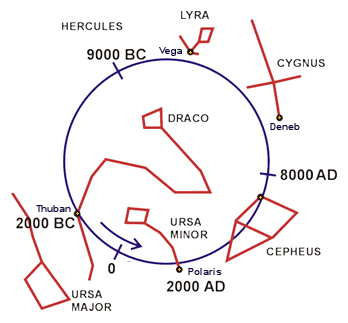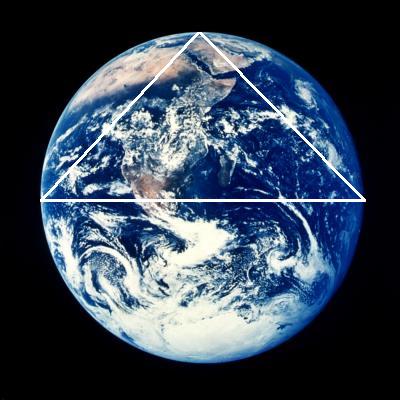|
 The Precession of the Equinoxes:
(The 'Platonic Year'..)
The Precession of the Equinoxes:
(The 'Platonic Year'..)
It has been observed that certain ancient myths, sacred texts
and ancient buildings have �stored� within them, common and repeating
numerical values and dimensions which relate to astronomical phenomena.
This
knowledge appears to be based on the observation of the precession of
the equinoxes.
Quick-links:
The precession of the
equinoxes refers to the observable phenomena of the rotation of the heavens,
a cycle which
spans a period of (approximately) 25,920 years, over which time the constellations
appear to slowly rotate around the earth, taking turns at rising behind
the rising sun on the vernal equinox.
This remarkable cycle is due to a synchronicity between the speed of the
earth's rotation around the sun, and the speed of rotation of our galaxy.
|
The Precession of the equinoxes = 25,920 yrs =
(360�
rotation)
If the sky is divided into 12
constellations:
(25,920 / 12 = 2,160)
(Note: 6 x 10 x 6 = 360 and 360 x 6 =
2,160)
A New sign appears on the horizon each
2,160 yrs (30�)
Note: (2 x 2,160 or 12 x 360 =
4,320 yrs)
Therefore
to move 1�
on the horizon = 72
yrs. (approx).
|
The following numbers can therefore be regarded as precessionary:
(12 ... 30 ... 72 ... 360 ... 2,160 ... 4,320 and 25,920)
It is now suggested that at some point in the
distant past this cycle was
determined by astronomers (A process requiring the prolonged and precise
observation of the equinoxial conjunction of the rising sun and the 'suns
carrier' behind). Such a discovery goes a
long way to understanding the
prehistoric fascination with astronomy and the apparent 'will
to move mountains' exhibited by
the builders of many megalithic monuments. Lockyer observed that
prehistoric astronomy was started on the horizon, which would go a long
way towards explaining
the early development of the English structures called 'Henges',
with their built-up banks creating excellent artificial horizons.
The Precessionary cycle
is measured in 'months' named according to the constellation
visible behind the vernal equinox sunrise. We are presently
finishing the 'age of Pisces' and will be soon entering the 'age
of Aquarius'. It is suggested (and supported by a growing
weight of evidence), that this cycle was recognised at least as
far back as the age of Taurus, although there are suggestions of
recognition as far back as Leo (as represented by the
Sphinx at Giza).
|
Constellation (Represented by) |
Date as Suns 'Carrier' |
| |
|
|
Leo (Lion) |
10,800 - 8,640 BC |
|
Cancer (Crab) |
8,640 - 6,480 BC |
|
Gemini (Twins) |
6,480 - 4,320 BC |
|
Taurus (Bull) |
4,320 - 2,160 BC |
|
Aries (Ram) |
2,160 BC - 0 |
|
Pisces (Fish) |
0 - 2,160 AD |
|
Aquarius (Water jug) |
2,160 - 4,320 AD |
| |
|
Precession can also be measured through the tilt' of
the earths axis, which causes the polar position in the sky to change, with
a revolution of the earths axis around the true 'celestial pole' taking the same length of time, as the
following diagrams illustrate.


Where the blue circle in the diagram
(right), represents the path of the pole in the northern hemisphere over a
complete cycle.
The
following examples illustrate how the knowledge of 'the great cycle' was
stored around the ancient world.
Although there is no written
testimony of a recognition of precession before the Greeks, it is
clear from Greek testimony (such as from Aristotle), that Egyptian and
Babylonian sciences were shrouded in mystery and only available to the
'initiated'. However, this lack of written evidence by no means precludes
such knowledge from being understood, as the numbers that represent the
precessionary cycle (see above), can be
found in the dimensions of 'sacred' structures and mythologies from around
the ancient world as the following examples illustrate.
Turkey -
(See
Metsamor).
First recorded division of the
sky into 12 equal parts. Metsamor was identified by Livvio Stecchini
as an ancient oracle centre. It lies at the foot of Mount Ararat, and
archaeology has shown that the area was home to a sophisticated culture that
was present in Anatolia from c. 6,000 BC.
Sumeria
-
Gudea, a ruler of �Lagash�, of Sumeria, recorded that he was given
instructions in a vision. �A wise man that shone like the heaven,� by whose
side stood �a divine bird,� �commanded me to build this temple�. Gudea
employed a male �diviner, maker of decisions�, and a female �searcher of
secrets� to locate the site. He then recruited
216,000 people for the job.
(23).
Babylon
-
The Babylonian historian Berossus (third century BC) ascribed a total
reign of
432,000 years (120
shar�s of
3,600 yrs each), to
the mythical Kings who ruled the land of Sumer before the flood. He also
ascribed a period of
2,160,000 years to the period �between creation and universal
catastrophe�.
(21)
The King-List known as W-B/144, records the
following:-
�when kingship was lowered from heaven,
kingship was first in
Eridu�
The following lengths of time were given for
each ruler:-
|
Alulim � 28,000 yrs
Alalgar � 36,000
yrs
Enmenluanna �
43,200 yrs
Enmengalanna � 28,800 yrs
Dumuzi �
36,000
yrs
Ensipazianna �
21,600 yrs
Uburtutu � 18,000 yrs
|
The Sumerian text W-B/62, adds Larsa and its two divine
rulers to the King-List, also multiples of 3,600.
(23).
We can be fairly sure that the Sumerians
were aware of the cycle, as we can see from the table above that it
offers a natural division of both time and space into 360�, from units
of 6 and 10. The Sumerians are the earliest culture to measure both
time and space in units of 6 and 10. A system called the Hexi-decimal
system.
Remarkably, time and space are still
measured today by the same units of measurement. For example, we can
see the year divided by 12 months, with each day being divided by 24
hours, each one divisible by 60 minutes, and each minute by a further
60 seconds. Similarly, the earth is divided by 360 degrees, each
degree being divisible by 60 'minutes and each minute by a further 60
'seconds' of an arc.
China
-
Early Jesuit scholars, who were among the first Europeans to visit China
had the opportunity in the imperial library, to study a vast work consisting
of 4,320
volumes, said to have been handed down from ancient times and to contain
�all knowledge�. This great book included a number of traditions which told
of the consequences that followed when mankind rebelled against the high
gods and the system of the universe fell into disorder�: �The planets
altered their courses. The sky sank lower towards the north. The Sun, moon
and stars changed their motions. The earth fell to pieces and the waters in
its bosom rushed upwards with violence and overflowed the earth�. Extract
from
(21).
|
The Great Pyramid of Giza.
It has been shown that the exterior measurements of the 'Great' Pyramid
of Giza are an accurate representation of the Earth's� northern
hemisphere on a scale of
1:43,200.

A number that proves highly significant when one considers
the method of doubling/halving the numbers that was used in ancient
Egypt (kemi)
25,920 years / 12 = 2,160 (x 2 = 4,320)
In
relation to this, it has been pointed out that the possibility may exist
whereby the numbers expressing the Precessionary cycle (Approx' 26,000
yrs), when viewed as fractals may be translated into the 60-based system
of degrees (26� 00' 00"). Modern pocket electronic calculators
have a key (DD>DMS) for this function.
The Platonic Year of 25,920 yrs would produce the
following numbers:
25.92 (doubled) = 51.84 where, 51.84� is
51� 50' 24".
In other words, the angle of inclination
51� 50' 24" would express the decimal number 51.84�, which is the fractal
expression of double the 25,920 Platonic Year number (25920 x 2 = 51840).
This would mean that the angle of
inclination cited by Piazzi Smyth for the Great pyramid of Ghiza of 51�
51' 14" would reflect the decimal number 51.85399� or the fractal halved
to that of 25,926.995 years (51,85399/2=25,926.995). A number which
appears at very least, an extraordinary coincidence considering the
astronomical references to the pyramid throughout history.
(More
about the Great pyramid) |
Mayan -
The Mayan
long count is based on large figures ascribed to astronomical
observations. In this we find that 1 Tun = 360 days, 1
Katun =
7,200 days and 15
Katuns =
2,160,000
days. The great cycle was believed to last for 13 baktuns � 1,872,000 days.
The present cycle comes to an end on 22 December 2012 AD.
Norse
-
The Norse myth of the
432,000
fighters who sallied forth from Valhalla to do battle with the �Wolf�.
India
-
The tradition of bull veneration is still practiced in India today,
although it is becoming more watered down each year. In addition, it is said
that the Agnicayana fire-alter in
India has 10,800 bricks.
(21).
(Note 10,800 X 4 =
43,200).
The Rig Veda -
There are 10,800 stanzas in the Rigveda, the most ancient of the
Vedic texts. Each stanza is made of 40 syllables with the result that the
entire composition contains
432,000 syllables. In
the
Rigvega I:164 we read of the �12-spoked wheel in which the
720
sons of Agni are established�.
(21).
|
Biblical references:
The Old testament - This idea
finds substance in the old testament which has been interpreted as including
the symbolic transference from one sign to another. In the parable of the
mount, when Moses came down from the mountain he saw the people
worshipping a golden calf. This idol came from the Egyptians astrological
worship of the sun. The calf (Taurus the bull) represents the age in which
the Moses lived when he wrote the Torah. When history moved into the next
sign (Aries the ram), the Hebrews celebrated the approach of their Messiah
by blowing rams horns. The sign of Aries influenced many religions to adopt
the lamb of God concept.
The new testament - It can be seen
that the new testament is similarly endowed with symbolism in the figure of Christ, who
can be identified as heralding the age of Pisces. (remembering that
Christianity is often symbolised by a fish) Should this theory
one day be further substantiated, then quite apart from the fact that such
information was detected at such an early age, there is also an incredible
story to tell regards the perpetuation of such knowledge. |
The first recorded recognition of procession in Greece
was by the astronomer Hipparchus who, whilst compiling his famous star
catalogue (completed in 129 BC),
noticed that the positions of the stars had shifted in a systematic way
from earlier Babylonian (Chaldean) measures.
(Ref:
http://www.britannica.com )
The Platonic Year was named after Plato (427 - 347 BC) because of his
conviction of the intimate relationship between space and time. Plato
believed that the heavens were "designed" by God for the measurement of
time. He called one complete cycle of the bodies a 'Perfect Year'. He
wrote of it in two texts:
Timaeus and
The Republic...
In this wise and for these reasons
were generated Night and Day, which are the revolution of the one and
most intelligent circuit; and Month, every time that the Moon having
completed her own orbit overtakes the Sun; and Year, as often as the
Sun has completed his own orbit. Of the other stars the revolutions
have not been discovered by men (save for a few out of the many);
wherefore they have no names for them, nor do they compute and compare
their relative measurements, so that they are not aware, as a rule,
that the �wanderings� of these bodies, which are hard to calculate and
of wondrous complexity, constitute Time. Nevertheless, it is still
quite possible to perceive that the complete number of Time
fulfils the Complete Year when all the eight circuits, with
their relative speeds, finish together and come to a head, when
measured by the revolution of the Same and Similarly-moving. In this
wise and for these reasons were generated all those stars which turn
themselves about as they travel through Heaven, to the end that this
Universe might be as similar as possible to the perfect and
intelligible Living Creature in respect of its imitation of the
Eternal. (Paragraph 39 c-d) Timaeus).
It is argued (reasonably), that Plato was referring to was
the orbits of the known planets, and not the constellations.
Plato himself believed that knowledge of such a cycle was
already known far earlier by the Egyptians and Babylonains.
Related
Articles:
(Guilio
Magli. On the possible discovery of Precessional effects in ancient
astronomy.)
(Archaeoastronomy)
(Sacred
Geometry)
|


